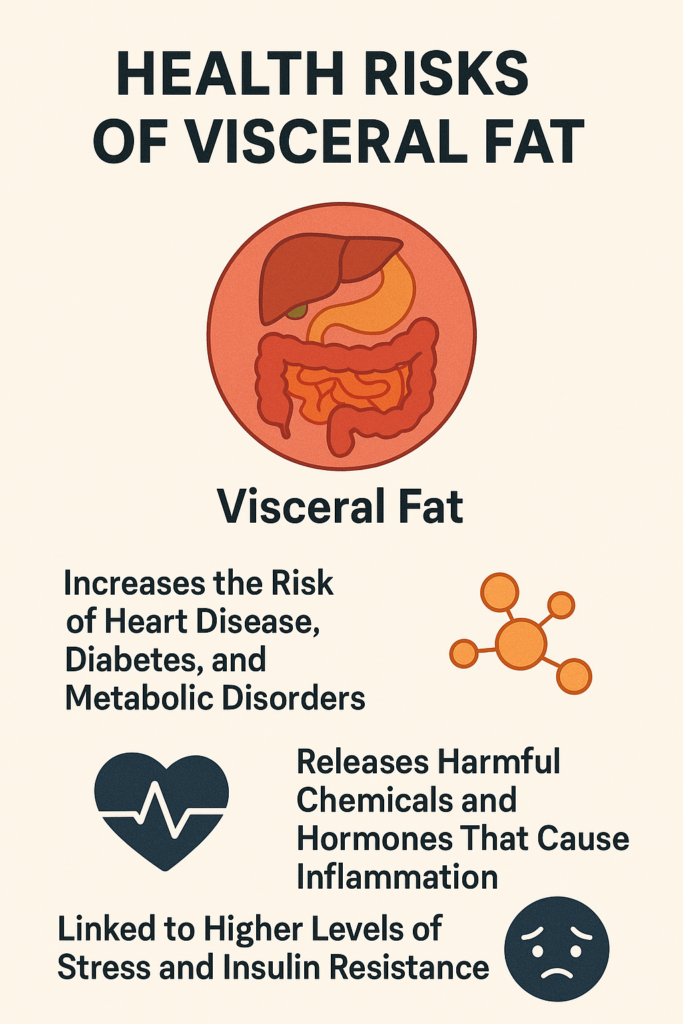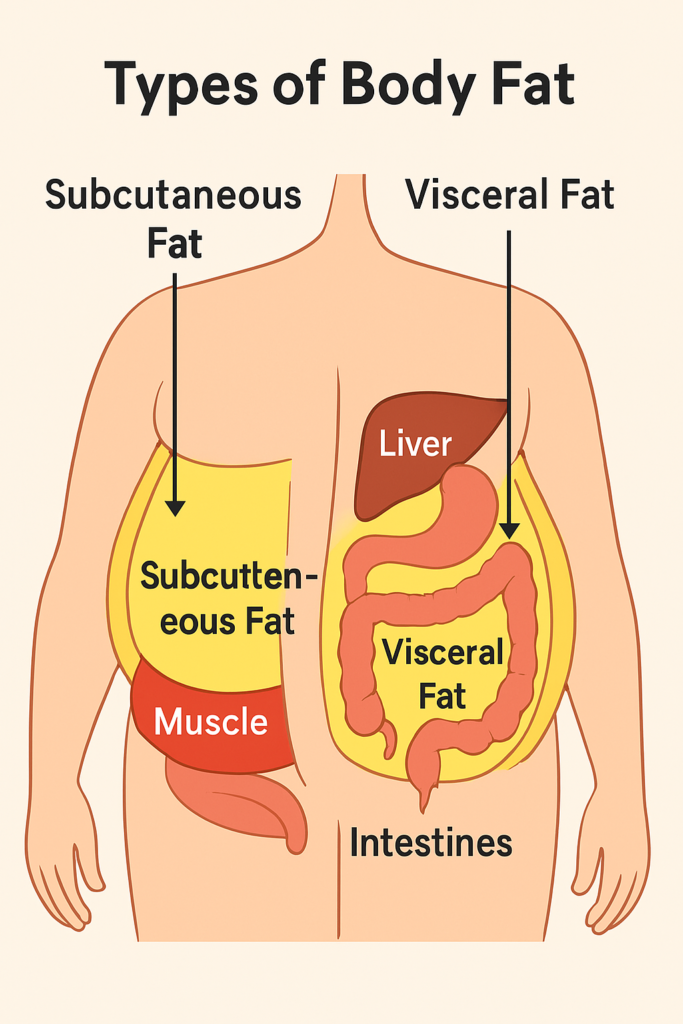Why Belly Fat Is Different from Other Fat—and How to Lose It
If you’ve been wondering how to lose belly fat, you’re not alone—and the answer matters more than just for appearance. Belly fat, especially visceral fat that wraps around internal organs, poses serious health risks like heart disease, type 2 diabetes, and high blood pressure. Unlike fat in other areas, it’s more active and harmful, making it harder to lose and more dangerous to keep
When people talk about losing weight, what they often mean—whether they realize it or not—is losing belly fat. And while it’s easy to think of belly fat as just an aesthetic issue, the truth is far more serious. Belly fat, particularly the kind that surrounds your internal organs, plays a unique role in your overall health. It’s not only harder to lose than other fat, but it also behaves differently—and more dangerously.
In this article, we’ll explore why belly fat is different from other types of fat, what makes it so difficult to shed, and most importantly, how you can get rid of it in a safe, effective, and sustainable way.
Belly Fat Is More Than Skin Deep
At first glance, all fat may seem the same. However, fat isn’t just an inert substance that your body stores when you eat too much. Instead, it plays a variety of roles—some helpful, others harmful—depending on where it is located in the body.
Broadly speaking, there are two main types of fat:
- Subcutaneous Fat – found just beneath the skin.
- Visceral Fat – found deep inside the abdomen, surrounding internal organs like the liver, stomach, and intestines.
Understanding the difference between these types is crucial if you want to understand why belly fat matters.
1. Subcutaneous Fat: The Less Harmful Kind
Subcutaneous fat is the soft, squishy fat you can grab with your fingers. It’s most commonly found around the thighs, hips, arms, and lower belly.
- Functionally, it provides insulation, helps regulate body temperature, and cushions the skin from trauma.
- Health-wise, it is not considered especially dangerous unless it’s present in excessive amounts. Even then, it’s more associated with cosmetic concerns than health risks.
- Interestingly, subcutaneous fat can actually be helpful in small amounts, serving as an energy reserve and assisting with hormone regulation.
While it can certainly contribute to being overweight, subcutaneous fat isn’t the villain when it comes to chronic health conditions.
2. Visceral Fat: The Dangerous Kind
Here’s what makes it particularly dangerous:
- It is metabolically active, meaning it doesn’t just sit there—it acts like a toxic organ, releasing chemicals that disrupt your metabolism.
- It produces inflammatory substances, including cytokines, that interfere with hormones like insulin and leptin.
- It is strongly linked to life-threatening diseases, including:
- Heart disease
- Type 2 diabetes
- High blood pressure
- Stroke
- Certain cancers
- Fatty liver disease
Unlike subcutaneous fat, visceral fat isn’t visible to the eye, which makes it even more insidious. In fact, many people who appear thin may still carry dangerous levels of visceral fat around their organs—a condition often referred to as “TOFI” (thin outside, fat inside).

Why Visceral Fat Is So Harmful
While all excess fat can cause some problems, visceral fat causes system-wide issues because of how it interacts with the body’s hormonal and metabolic systems.
1. Disrupts Hormonal Balance
Visceral fat actively produces hormones and inflammatory chemicals that throw your entire system out of balance. For example:
- Cortisol, the stress hormone, becomes elevated, encouraging even more fat storage in the belly.
- Leptin, which helps regulate hunger, becomes less effective, causing you to eat more.
- Insulin, which regulates blood sugar, struggles to do its job, increasing your risk of insulin resistance and type 2 diabetes.
2. Raises the Risk of Chronic Inflammation
Chronic inflammation has been linked to virtually every major disease—from cardiovascular problems to Alzheimer’s to cancer. Visceral fat is a primary contributor to this inflammation, releasing inflammatory molecules that affect tissues throughout the body.
3. Increases the Risk of Metabolic Syndrome
Metabolic syndrome is a cluster of conditions that occur together: high blood sugar, high blood pressure, abnormal cholesterol levels, and excess abdominal fat. Visceral fat is a major driver of this syndrome, which significantly increases the risk of heart disease and diabetes.
Why Belly Fat Is Hard to Lose
Even with consistent dieting and exercise, many people find belly fat particularly stubborn. This is because belly fat isn’t just about calories—it’s about hormones, stress, sleep, and even genetics.
Let’s take a closer look at the factors that make belly fat so tough to eliminate.
1. Hormonal Factors: Cortisol & Insulin Resistance
Your hormones have a huge impact on how and where your body stores fat.
- Cortisol, which rises during times of stress, sends a signal to your body to store fat in the abdominal region.
- Insulin resistance, often caused by visceral fat itself, makes it harder for your body to use glucose properly. Instead of burning it for energy, your body stores it as fat—primarily around your midsection.
How to fight back:
- Practice stress management techniques such as yoga, meditation, deep breathing, and journaling.
- Get enough sleep—at least 7 to 9 hours a night.
- Avoid high-sugar and high-carb diets that spike insulin levels.
2. Genetic Factors and Body Type
Unfortunately, your genetics also play a role. If your parents or close relatives carry weight around the middle, there’s a good chance you’re predisposed to do the same.
There are generally two body shapes:
- Apple-shaped bodies: Tend to carry more weight in the abdomen.
- Pear-shaped bodies: Tend to carry more fat in the hips and thighs.
Although you can’t change your genetics, you can change your habits. Full-body fat loss strategies can help shrink visceral fat over time.
3. Lifestyle Factors: Sleep, Diet, and Stress
Even if you’re eating well and exercising, poor sleep and chronic stress can sabotage your results.
Lack of Sleep:
Sleep affects every part of your metabolism. When you don’t sleep enough:
- Ghrelin (hunger hormone) increases.
- Leptin (satiety hormone) decreases.
- Cortisol spikes.
This hormonal mix leads to late-night cravings, poor food choices, and fat storage—especially in the belly.
Stress:
Long-term stress keeps cortisol elevated, which—as mentioned earlier—tells your body to store more belly fat. Plus, stress often leads to emotional eating and cravings for unhealthy, high-calorie foods.
Diet:
Highly processed foods, sugary snacks, trans fats, and excessive alcohol intake all contribute to belly fat accumulation. Conversely, diets high in whole foods, fiber, lean protein, and healthy fats can help reduce it.
The Good News: Visceral Fat Is Reversible
Here’s the encouraging part—you can lose visceral fat, and you don’t need extreme dieting to do it.
Proven strategies to reduce belly fat:
- Exercise regularly: A mix of cardio (like walking or swimming) and strength training works best.
- Eat mindfully: Focus on whole, nutrient-dense foods. Avoid sugar, refined carbs, and processed snacks.
- Get quality sleep: 7–9 hours of uninterrupted sleep is ideal.
- Manage stress: Incorporate relaxing practices into your daily routine.
- Stay consistent: Progress may be slow, but steady habits always win.

Final Thoughts: Why This Matters
Belly fat isn’t just about how you look in the mirror—it’s a reflection of what’s happening inside your body. Visceral fat is dangerous, persistent, and deeply connected to the risk of life-threatening diseases.
Fortunately, with the right approach, you can take control. Small, sustainable changes in your daily routine—especially in stress management, sleep hygiene, diet, and exercise—can help you not only shed belly fat but also live a longer, healthier life.
So, if you’re tired of struggling with belly fat, don’t give up. Understanding what makes it different is the first step. Why Belly Fat Is Different from Other Fat—and How to Lose It. From there, consistent action—guided by awareness, not extremes—can lead to long-term success.
